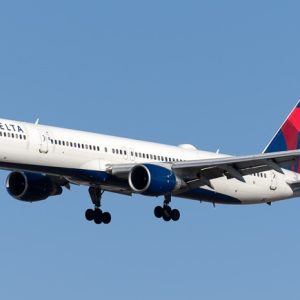
Lightning is one of the biggest weather-related threats to the aviation industry and is responsible for delaying millions of passengers each year.
Thunderstorms can pose a significant risk to ground handlers and are also a dangerous environment for an aircraft to fly through.
Consequently, airports typically put a halt to operations during thunderstorms and won’t allow flight movements to resume until the storm has passed, leading to considerable delays for airlines and their passengers.
During peak periods when a high number of flights are canceled, the knock-on effect on delays and cancelations can be a huge pain for all involved.
According to a report from Vaisala, a global leader in measurement technology, the world’s worst airports for lightning risk are concentrated in Southeast Asia, although other airports (including in Florida) also score highly for lightning-related disruption.
The worst airport – Kuala Lumpur (KUL) – saw over 13,000 minutes of lightning risk last year, consequently causing considerable disruption to the airport’s operations.
The company measured lightning activity at the world’s 50 busiest airports over a span of a decade, discovering that peak periods differ greatly depending on the time of day or year.
By understanding these patterns, airlines can schedule their operations around avoiding the worst periods.
So, what are the world’s worst airports for lightning activity, and what can authorities and airlines do to mitigate the effect of thunderstorms?
Southeast Asia sees most lightning warnings
Given its tropical climate featuring high humidity and temperatures, Southeast Asia has always been a rough region for weather events.
According to Vaisala’s report, the airport that experienced the highest number of lightning risk minutes was Kuala Lumpur International, closely followed by Vietnam’s Tan Son Nhat International.
As seen in the table below, the top six airports are all in Southeast Asia, and a seventh – Guangzhou Baiyun International – makes up the top ten. Two Florida airports – Miami and Orlando – also rank highly.
Rank | Airport | Lightning Risk Minutes |
|---|---|---|
1 | Kuala Lumpur International (KUL) | 13,058 |
2 | Tan Son Nhat International (SGN) | 10,512 |
3 | Singapore Changi (SIN) | 9,954 |
4 | Ninoy Aquino International (MNL) | 8,792 |
5 | Soekarno-Hatta International (CGK) | 8,580 |
6 | Suvarnabhumi International (BKK) | 7,187 |
7 | Miami International (MIA) | 6,737 |
8 | Orlando International (MCO) | 6,431 |
9 | Guangzhou Baiyun International (CAN) | 6,391 |
10 | George Bush Intercontinental (IAH) | 5,206 |
Given the tens of millions of passengers passing through each of these airports annually, lightning-related suspensions in flight movements have a huge knock-on effect.
Delays prove costly for airlines, with an Airlines for America (A4A) report from last year estimating an average direct cost of $100 for every minute an aircraft spends on the ground.
However, the overall cost per minute for all stakeholders can be a lot higher, with Vaisala putting it in the “thousands of dollars a minute” bracket.
There can be all kind of costs that come with rescheduling, knock-on delays and even the use of alternative airports, while the need for replacement crews can further complicate matters.
Least lightning-prone airports
Not all airports have it so bad with lightning. Compared to the airports above, the ten airports with the lowest risk of lightning events were as follows:
Rank | Airport | Lightning Risk Minutes |
|---|---|---|
41 | Amsterdam Schiphol (AMS) | 612 |
42 | King Abdulaziz International (JED) | 483 |
43 | Xi’an Xianyang International (XIY) | 417 |
44 | Hamad International (DOH) | 378 |
45 | Dubai International (DXB) | 318 |
46 | London Gatwick (LGW) | 278 |
47 | London Heathrow (LHR) | 269 |
48 | Seattle-Tacoma International (SEA) | 131 |
49 | Los Angeles International (LAX) | 110 |
50 | San Francisco International (SFO) | 58 |
Delays and disruption
The aviation industry has its fair share of travel chaos due to one problem or another.
Lightning activity is unlikely to lead to a single epic meltdown and days of airport hell (like say, an IT outage or winter storm might), but its impact all adds up, leading to significant downtime for aircraft.
Industry guidelines state that when lightning storms are near an airport (usually within a 3 or 5-mile radius), then operations need to be halted until the adverse weather moves on.
In order for an airport to resume operations, it has to reach what is called a ‘clear time’ – this is defined as the time between the last lightning event and the decision to restart flights.
The Federal Aviation Administration (FAA) advises a clear time of 10 minutes, but the amount of time can vary from airport to airport.
While this is important from a safety perspective, it typically leads to “average downtimes of 30–60 minutes per lightning episode.” As explained by Ryan Said, Senior Lightning Scientist at Vaisala,
“Airports are open spaces with large numbers of staff working outside and near structures that attract lightning. To keep personnel and passengers safe, operations are halted when a thunderstorm rolls overhead. The inevitable delays cost airlines millions each year and disrupt travel.”
However, the industry could start using weather data to implement more optimal scheduling practices that would help minimize the impact of thunderstorms.
This is because, according to Vaisala, “these disruptions tend to follow predictable patterns,” which would allow carriers to make intelligent decisions around flight timings, or even rerouting to different airports.
As explained by Vaisala,
“Airlines can reduce the risks of delays caused by thunderstorms by scheduling routes through U.S. airports with lower lightning risk and having early morning flights during the peak lightning months of May through August.”
For example, when comparing lightning activity at Dallas/Fort Worth with data from Singapore Changi, there are some clear differences in monthly risk levels:
When analyzing the hour-to-hour data, it reveals an even clearer pattern:
Using this data, airlines can see that Singapore Changi tends to be hit by thunderstorms mostly during the months of April, May, October and November, and they mostly occur in the afternoon.
Meanwhile, DFW’s lightning activity peaks in the spring, but it is more evenly spread out throughout the day. As the report summarizes,
“Thunderstorms occur more frequently at specific times and months, meaning airlines can plan their schedules to reduce costs and the related domino effects on flight transfers.”
Avoiding peak lightning periods
Using the United States as a case study, the report found that most of the country experiences an uptick in lightning activity “in the afternoon through the late evening and during the summer months.”
Looking at the data from Florida’s Orlando International, the risk of lightning shoots up dramatically between 12:00 and 18:00, while the worst months by a considerable distance are June, July, August and September.
The FAA’s guidelines on lightning alerts recommend that airports establish a 5-mile (8 km) alerting distance and 10-minute clear time.
However, as Vaisala notes, lightning can still hit up to 10 miles (16 km) away from a storm and “can strike before the rain arrives and even afterwards when the clouds are dissipating.”
Monthly distribution
A clear pattern can be seen between the hemispheres when it comes to peak months of lightning activity. In the Southern Hemisphere, activity is heightened during the year’s early months, while regions near the equator tend to see more activity in mid-year months.
Are aircraft safe from lightning?
Yes, modern aircraft are designed to resist lightning strikes, although this does not mean they should be considered completely immune to damage.
The interior of the plane, including its wires and electrical systems, is protected as the aircraft’s exterior acts as a Faraday cage – however, it is not unheard of for an aircraft to sustain a degree of damage from a lightning strike.
This damage will usually be superficial but still require checks and possible maintenance to make the plane airworthy. If an aircraft is struck during a flight, the crew can decide whether to continue the flight or make a precautionary landing.
There have been plenty of cases where an aircraft has continued its journey without issue, but if damage is suspected then the plane will generally divert.
The last confirmed time a lightning strike directly led to an air crash was back in 1968 with Pan Am Flight 214. On that occasion, a lightning strike ignited fuel vapor, which caused a fuel tank to explode, leading to the death of all 81 souls onboard.
Aircraft manufacturers and regulators keep on top of the issue, designing more resistant planes and ensuring regulations are stringently met.
Last year, the FAA issued an airworthiness directive (AD) regarding possible encapsulation and bonding failures on the Boeing 777 which could theoretically lead to a fuel tank explosion during a lightning strike.





